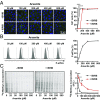Small molecule ISRIB suppresses the integrated stress response within a defined window of activation
- PMID: 30674674
- PMCID: PMC6369741
- DOI: 10.1073/pnas.1815767116
Small molecule ISRIB suppresses the integrated stress response within a defined window of activation
Erratum in
-
Correction to Supporting Information for Rabouw et al., Small molecule ISRIB suppresses the integrated stress response within a defined window of activation.Proc Natl Acad Sci U S A. 2021 Apr 27;118(17):e2103599118. doi: 10.1073/pnas.2103599118. Proc Natl Acad Sci U S A. 2021. PMID: 33875607 Free PMC article. No abstract available.
Abstract
Activation of the integrated stress response (ISR) by a variety of stresses triggers phosphorylation of the α-subunit of translation initiation factor eIF2. P-eIF2α inhibits eIF2B, the guanine nucleotide exchange factor that recycles inactive eIF2•GDP to active eIF2•GTP. eIF2 phosphorylation thereby represses translation. Persistent activation of the ISR has been linked to the development of several neurological disorders, and modulation of the ISR promises new therapeutic strategies. Recently, a small-molecule ISR inhibitor (ISRIB) was identified that rescues translation in the presence of P-eIF2α by facilitating the assembly of more active eIF2B. ISRIB enhances cognitive memory processes and has therapeutic effects in brain-injured mice without displaying overt side effects. While using ISRIB to investigate the ISR in picornavirus-infected cells, we observed that ISRIB rescued translation early in infection when P-eIF2α levels were low, but not late in infection when P-eIF2α levels were high. By treating cells with varying concentrations of poly(I:C) or arsenite to induce the ISR, we provide additional proof that ISRIB is unable to inhibit the ISR when intracellular P-eIF2α concentrations exceed a critical threshold level. Together, our data demonstrate that the effects of pharmacological activation of eIF2B are tuned by P-eIF2α concentration. Thus, ISRIB can mitigate undesirable outcomes of low-level ISR activation that may manifest neurological disease but leaves the cytoprotective effects of acute ISR activation intact. The insensitivity of cells to ISRIB during acute ISR may explain why ISRIB does not cause overt toxic side effects in vivo.
Keywords: ISRIB; P-eIF2; eIF2B; integrated stress response.
Copyright © 2019 the Author(s). Published by PNAS.
Conflict of interest statement
Conflict of interest statement: P.W. [University of California, San Francisco (UCSF) employee] currently holds ISRIB-related patents. These patents are licensed by UCSF to Genentech and Calico.
Figures





Similar articles
-
ISRIB Blunts the Integrated Stress Response by Allosterically Antagonising the Inhibitory Effect of Phosphorylated eIF2 on eIF2B.Mol Cell. 2021 Jan 7;81(1):88-103.e6. doi: 10.1016/j.molcel.2020.10.031. Epub 2020 Nov 20. Mol Cell. 2021. PMID: 33220178 Free PMC article.
-
Binding of ISRIB reveals a regulatory site in the nucleotide exchange factor eIF2B.Science. 2018 Mar 30;359(6383):1533-1536. doi: 10.1126/science.aar5129. Science. 2018. PMID: 29599245 Free PMC article.
-
Structural insights into ISRIB, a memory-enhancing inhibitor of the integrated stress response.FEBS J. 2020 Jan;287(2):239-245. doi: 10.1111/febs.15073. Epub 2019 Nov 7. FEBS J. 2020. PMID: 31550413 Review.
-
Pharmacological dimerization and activation of the exchange factor eIF2B antagonizes the integrated stress response.Elife. 2015 Apr 15;4:e07314. doi: 10.7554/eLife.07314. Elife. 2015. PMID: 25875391 Free PMC article.
-
Surviving and Adapting to Stress: Translational Control and the Integrated Stress Response.Antioxid Redox Signal. 2023 Aug;39(4-6):351-373. doi: 10.1089/ars.2022.0123. Epub 2023 May 9. Antioxid Redox Signal. 2023. PMID: 36943285 Free PMC article. Review.
Cited by
-
Endoplasmic reticulum stress targeted therapy for breast cancer.Cell Commun Signal. 2022 Nov 7;20(1):174. doi: 10.1186/s12964-022-00964-7. Cell Commun Signal. 2022. PMID: 36345017 Free PMC article. Review.
-
Protein quality control: from mechanism to disease : EMBO Workshop, Costa de la Calma (Mallorca), Spain, April 28 - May 03, 2019.Cell Stress Chaperones. 2019 Nov;24(6):1013-1026. doi: 10.1007/s12192-019-01040-9. Epub 2019 Nov 11. Cell Stress Chaperones. 2019. PMID: 31713048 Free PMC article.
-
Precision analysis of mutant U2AF1 activity reveals deployment of stress granules in myeloid malignancies.Mol Cell. 2022 Mar 17;82(6):1107-1122.e7. doi: 10.1016/j.molcel.2022.02.025. Mol Cell. 2022. PMID: 35303483 Free PMC article.
-
Small Molecule Modulation of the Integrated Stress Response Governs the Keratoconic Phenotype In Vitro.Invest Ophthalmol Vis Sci. 2019 Aug 1;60(10):3422-3431. doi: 10.1167/iovs.19-27151. Invest Ophthalmol Vis Sci. 2019. PMID: 31390655 Free PMC article.
-
Prognostic value of SEC61G in lung adenocarcinoma: a comprehensive study based on bioinformatics and in vitro validation.BMC Cancer. 2021 Nov 13;21(1):1216. doi: 10.1186/s12885-021-08957-4. BMC Cancer. 2021. PMID: 34774014 Free PMC article.
References
-
- Arimoto K, Fukuda H, Imajoh-Ohmi S, Saito H, Takekawa M. Formation of stress granules inhibits apoptosis by suppressing stress-responsive MAPK pathways. Nat Cell Biol. 2008;10:1324–1332. - PubMed
-
- Takahara T, Maeda T. Transient sequestration of TORC1 into stress granules during heat stress. Mol Cell. 2012;47:242–252. - PubMed
-
- Pain VM. Initiation of protein synthesis in eukaryotic cells. Eur J Biochem. 1996;236:747–771. - PubMed

